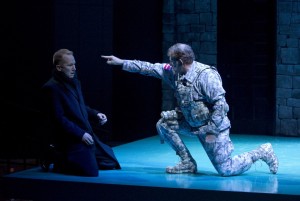What happens when a character’s language cannot be spoken
but can be communicated visually?

Henry Seago as Poins in 1 Henry IV (OSF, 2010).
This is one of the first questions Michael W. Shurgot asks in his analysis of the translation of a particularly “tricky” language to use in a Shakespearean play: American Sign Language (ASL). Whereas American-English speaking actors can “translate” Shakespearean language through enunciation and the use of American accents, it becomes extremely difficult when there is no Shakespearean era equivalent to the language a character is trying to use. This was the predicament actor Howie Seago found himself in when he was cast as Poins in the production of 1 Henry IV at the 2010 Oregon Shakespeare Festival (OSF). In his essay, Shurgot references the performance of Seago as well as an interview he conducted with the actor. He also discusses the intentionality of using a deaf actor and creating a deaf character by the director of the production, Penny Metropulos.
During the 2010 OSF season, Seago was also cast in two other plays: as Tubal in The Merchant of Venice and as the Ghost in Hamlet. With the Oregon Shakespeare Festival taking place in Ashland, Oregon, which is about 45 miles from my hometown, I was able to see Seago’s portrayal as the Ghost in Hamlet. My favorite production of any play I have seen to date, I thoroughly enjoyed the added layer of distance and disconnect provided by having a “silent” Ghost communicate with Hamlet. Unfortunately, I did not see Seago’s performance as Poins, but it was extremely interesting to learn about the insight and forethought that necessarily goes into the blocking and interpretation of a scene involving a deaf character.
Shurgot explains that Metropulos purposely casted Seago in the role of Poins to emphasize his outsider-ness, particularly in the scene where Poins finds himself in the tavern in 2.4. In order to ensure that Poins’ interactions made sense, various characters interpreted the lines of other characters while they spoke. Additionally, Seago recalls having “the bright idea of falling asleep during the long ‘play-within-the-play’” scene so as to avoid long bouts of interpretation (Shurgot 28). Despite being deaf since birth, Seago still has the ability to audibly speak when the script calls for it. This became necessary when Hal and Poins play their prank on Francis. Seago would transition to an area of the stage closer to the audience and yell “Francis” loud enough for the audience to hear (Shurgot 28). Francis would then sign something that translated to “Hold on!” while simultaneously uttering “Anon, Anon.” In order to emphasize the ridiculousness of the event, Poins and Hal physically mimic Francis utilizing ASL instead of verbally mocking him. Overall, Shurgot mentions, the scene moved quickly and while audiences were aware of the signing going on, it did not detract from the action on stage. What’s more is that Seago’s portrayal in many ways added new and exciting layers to the interpretation of the scene and the character of Poins. Not only did it accentuate his status as an outsider, but it “emphasized the delicious irony that the deaf character on stage was far more ‘articulate’ than the hearing character Francis” (Shurgot 29).
The use of non-standardized English speaking characters is a fantastic way to modernize a Shakespeare play. Should Seago ever return to the Oregon Shakespeare Festival, I hope I am in town to witness his memorable performance one more time.
Citations:
Shakespeare, William. “The First Part of Henry the Fourth.” The Complete Pelican Shakespeare. Eds. Stephen Orgel, and A R. Braunmuller. New York, NY: Penguin Books, 2002. 1044-1079. Print.
Shurgot, Michael W. “Breaking the Sound Barrier: Howie Seago and American Sign Language at Oregon Shakespeare Festival.”Shakespeare Bulletin: A Journal of Performance Criticism and Scholarship 30.1 (2012): 21-36. ProQuest. Web.

